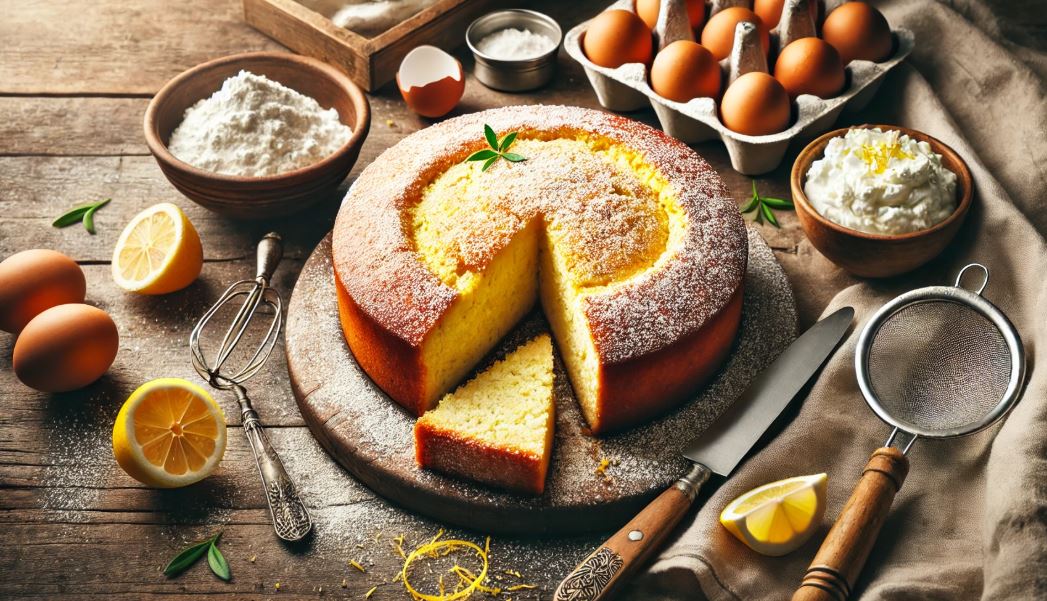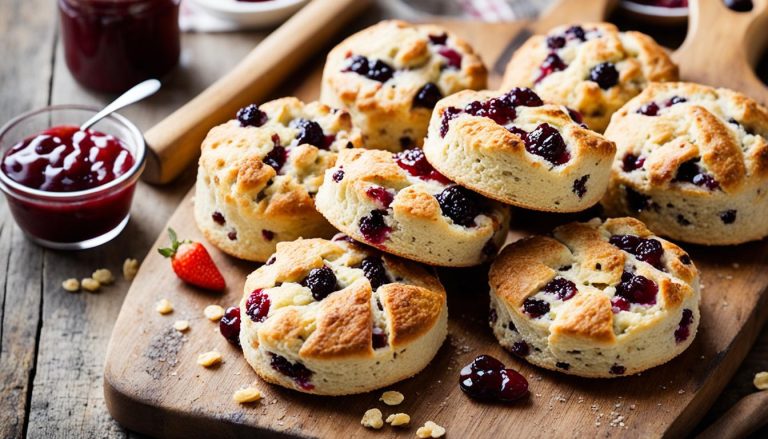Ricotta cake is a timeless Italian dessert that brings together delicate flavour and creamy texture in every slice. As someone who’s tested countless versions in my kitchen, I’ve found this recipe captures bakery-style perfection with minimal effort.
Whether served as an afternoon indulgence or a dinner party finale, its simplicity makes it a home baker’s favourite. This guide walks you through selecting the right ingredients, mastering the technique, and customising it to suit any occasion.
What is Ricotta Cake?
Ricotta cake is a traditional Italian dessert that blends the richness of cheese with the softness of a sponge-style cake. At its heart, it’s a moist, subtly sweet cake made using ricotta cheese, which gives it a creamy texture unlike any other baked dessert.
As someone who’s baked for over a decade, I’ve found ricotta cake to be one of the most elegant yet achievable cakes to master at home. It stands out for its simplicity, versatility, and the way it complements both bold citrus notes and classic vanilla.
Historically rooted in Southern Italy, the ricotta cake has evolved to include regional variations, some incorporating lemon zest, almonds, or even a splash of liqueur. The texture is often compared to a mix between sponge and cheesecake, making it ideal for those who enjoy light desserts with a rich bite.
Ingredients for Ricotta Cake Recipe

The success of a ricotta cake rests heavily on ingredient selection. Each component plays a crucial role in determining flavour, texture, and overall presentation. Here’s a breakdown of everything you’ll need, including specifications for quality and taste.
Ingredients Table
| Ingredient | Quantity | Specifications |
| Ricotta cheese | 400g | Full-fat, well-drained Italian ricotta preferred |
| Unsalted butter | 115g | Softened, room temperature |
| Caster sugar | 200g | Fine grain, white sugar |
| Eggs | 3 large | Free-range, room temperature |
| Plain flour | 180g | Sifted for a lighter crumb |
| Baking powder | 1½ tsp | Fresh, aluminium-free if possible |
| Lemon zest | 1 tbsp | Freshly grated from unwaxed lemons |
| Vanilla extract | 2 tsp | Pure vanilla, not essence |
| Salt | ¼ tsp | Enhances flavour and balances sweetness |
| Icing sugar (for dusting) | As needed | Optional, for serving |
Notes on Quality
- Always drain the ricotta overnight if it seems watery.
- Use fresh lemon zest, pre-packed lemon flavourings don’t offer the same brightness.
- For an added twist, substitute half the sugar with light brown sugar for a caramelised note.
Getting your ingredients right ensures your ricotta cake comes out moist, well-risen, and flavour-balanced.
Step-by-Step Method for Making a Moist Ricotta Cake

Making a moist and tender ricotta cake requires careful attention to both mixing technique and baking time. Here’s how I do it in my kitchen for that perfect result every time.
- Preheat your oven to 180°C (160°C fan)/350°F. Grease and line a 20cm springform cake tin with parchment paper.
- Cream butter and sugar until light and fluffy (about 3 minutes using a stand mixer or handheld beater).
- Add the eggs, one at a time, beating well after each addition. The batter may look slightly curdled, this is normal.
- Fold in the ricotta, lemon zest, and vanilla extract using a spatula. Avoid overmixing to retain air.
- Sift in the flour, baking powder, and salt. Fold until combined and smooth.
- Pour the batter into the prepared tin and smooth the top.
- Bake for 45–55 minutes until a skewer inserted into the centre comes out clean or with a few moist crumbs.
- Cool in the tin for 10 minutes, then transfer to a wire rack. Dust with icing sugar once cooled.
With these precise steps, you’ll get a golden crust and a melt-in-the-mouth crumb that’s irresistibly tender.
How Do I Achieve a Light and Fluffy Texture Every Time?
The texture of a ricotta cake should never be dense or soggy. The goal is a delicate crumb that holds its shape yet feels moist and airy. Here’s how I ensure bakery-style fluffiness:
- Drain the ricotta properly. Watery cheese will weigh the batter down.
- Cream the butter and sugar thoroughly. This introduces air, creating a lighter structure.
- Use room temperature ingredients. Eggs and butter blend better when not cold.
- Don’t overmix the flour. Overworking the gluten results in toughness.
- Use a gentle folding motion for final mixing—treat it like a sponge cake, not a loaf.
- Avoid opening the oven door during baking, especially in the first 30 minutes.
If you follow these techniques, you’ll get a consistent texture every time, even without professional tools or commercial ovens.
Can I Use Different Flavours in a Ricotta Cake?
Absolutely. Ricotta cake is a perfect canvas for a wide range of flavours. While lemon and vanilla are the most common pairings, I love experimenting with seasonal and regional ingredients.
Popular Flavour Variations
- Citrus: Try orange or lime zest in place of lemon.
- Almond: Add ½ tsp almond extract and scatter flaked almonds on top before baking.
- Chocolate chip: Fold in 100g of dark chocolate chips for a richer dessert.
- Berry: Add 100g fresh raspberries or blueberries to the batter.
- Liqueurs: Amaretto, Limoncello, or Grand Marnier can add depth and aroma.
Flavouring ricotta cake is as simple as balancing your add-ins to avoid overwhelming the light texture. Keep any extras under 150g to maintain structure.
How Long Should I Bake a Ricotta Cake, and at What Temperature?
Baking time and temperature are critical for the perfect texture. Undercooked ricotta cake will collapse or feel wet, while overbaking leads to dryness.
Guidelines
- Standard oven: 180°C (160°C fan) / 350°F
- Bake time: 45 to 55 minutes
- Visual cues: Golden brown top, firm centre, and edges pulling slightly from the pan
- Test with a skewer: Should come out with a few moist crumbs but no raw batter
- Avoid opening the oven early: Sudden temperature drops can cause sinking
I always recommend checking your cake at the 45-minute mark. If it needs more time, continue baking in 5-minute intervals.
How Do I Store and Serve Ricotta Cake for the Best Flavour?

A freshly baked ricotta cake is best enjoyed at room temperature, but proper storage can extend its life and maintain quality.
Storage Tips
- Room temperature: Store in an airtight container for up to 2 days.
- Refrigeration: Keeps well in the fridge for 5 days. Let it sit out before serving to bring back softness.
- Freezing: Wrap slices individually in clingfilm and foil. Freeze up to 2 months.
Serving Suggestions
- Dust with icing sugar
- Add whipped cream or Greek yoghurt
- Garnish with fresh berries or citrus slices
- Drizzle with honey or fruit compote
The flavours develop beautifully by the second day, making it ideal for preparing ahead of time.
What’s the Secret to a Bakery-Style Finish at Home?
Bakery-style finish is all about presentation and polish. Even at home, you can make your ricotta cake look like it came from a patisserie.
Finishing Touches
- Even batter spread: Ensures uniform rise
- Use of a springform tin: For clean edges and easy release
- Fine icing sugar dusting: Gives a light, elegant look
- Top with thin citrus slices or edible flowers
- Optional glaze: Make a lemon glaze with icing sugar and juice for a glossy top
Take care in the small details and your ricotta cake will look as amazing as it tastes.
Can Ricotta Cake Be Made Gluten-Free or Dairy-Free?
Yes, you can adapt this recipe for dietary needs without compromising much on flavour or texture.
Gluten-Free Adaptation
- Replace plain flour with a 1:1 gluten-free baking blend.
- Add ¼ tsp xanthan gum if your blend doesn’t include it.
Dairy-Free Adaptation
- Substitute ricotta with a vegan ricotta alternative (almond-based works well).
- Use plant-based butter and dairy-free milk if needed.
Nutritional Table (Per Slice, Approx. 10 slices)
| Nutrient | Amount |
| Calories | 310 kcal |
| Protein | 9g |
| Carbohydrates | 34g |
| Sugars | 20g |
| Fat | 16g |
| Saturated Fat | 9g |
| Fibre | 1g |
| Sodium | 180mg |
Adjustments for special diets are increasingly popular and allow everyone to enjoy this comforting cake.
What Are the Best Occasions to Serve Ricotta Cake?

Ricotta cake is versatile enough for nearly any occasion. Whether casual or elegant, it fits beautifully on the menu.
Perfect Occasions
- Afternoon tea with friends
- Festive holidays like Easter or Christmas
- Dinner party dessert
- Birthdays or anniversaries for those who dislike overly sweet cakes
- Picnics or rustic-themed events
Its understated elegance and gentle sweetness make it a crowd-pleaser. You can even bake it in mini tins for individual portions.
Variations of Ricotta Cake Recipe
Tessa Huff’s Quick & Easy Lemon Ricotta Cake
- Fast, one-bowl mixing method
- Strong lemon zest flavour
- Beautiful golden crust with soft centre
Suzy Karadsheh’s Mediterranean-Inspired Ricotta Cake
- Light texture
- Olive oil and honey for Mediterranean flair
- Citrus-forward with minimal sugar
Jessica Formicola’s Italian Lemon Ricotta Cake
- Authentic Italian family recipe
- Balanced sweetness
- Thick batter with bold lemon and vanilla notes
BBC’s Classic Baked Ricotta Cake
- Dense and creamy
- Classic British-Italian fusion
- Ideal with berry compote
Jess Holmes’ Sweet and Simple Ricotta Cake
- Straightforward method
- Bakery-quality finish
- Perfect for beginner bakers
Conclusion
There’s something incredibly satisfying about creating a dessert that’s both comforting and elegant. This ricotta cake recipe delivers just that, fluffy, moist, and rich without being overpowering.
Whether you’re following a classic lemon variation or experimenting with new flavours, this guide ensures you’ll get bakery-worthy results at home.
With a few well-chosen ingredients and careful preparation, you’ll have a cake that’s as beautiful to serve as it is to eat, time and time again.
FAQs
What makes ricotta cake different from cheesecake?
Ricotta cake is lighter and more sponge-like, while cheesecake is dense and creamy due to cream cheese.
Can I use low-fat ricotta cheese?
Yes, but the texture may be slightly drier. Full-fat ricotta delivers better moisture and richness.
Why did my ricotta cake sink in the middle?
It could be underbaked, or the batter was overmixed. Ensure you bake thoroughly and fold gently.
Is it possible to add fruit inside the ricotta cake?
Yes, berries like raspberries or blueberries work well. Toss them in flour before folding into the batter.
Can I make mini ricotta cakes in muffin tins?
Yes! Reduce the baking time to 20–25 minutes and monitor closely for doneness.

Ingredients
- 400 g Ricotta cheese Full-fatwell-drained Italian ricotta preferred
- 115 g Unsalted butter Softenedroom temperature
- 200 g Caster sugar Fine grain white sugar
- 3 large Eggs Free-range room temperature
- 180 g Plain flour Sifted for a lighter crumb
- 1½ tsp Baking powder Fresh aluminium-free if possible
- 1 tbsp Lemon zest Freshly grated from unwaxed lemons
- 2 tsp Vanilla extract not essence, Pure vanilla
- ¼ tsp tsp Salt Enhances flavour and balances sweetness
- Icing sugar for dusting As needed Optional, for serving
Instructions
- Preheat your oven to 180°C (160°C fan)/350°F. Grease and line a 20cm springform cake tin with parchment paper.400 g Ricotta cheese
- Cream butter and sugar until light and fluffy (about 3 minutes using a stand mixer or handheld beater).115 g Unsalted butter, 200 g Caster sugar
- Add the eggs, one at a time, beating well after each addition. The batter may look slightly curdled, this is normal.3 large Eggs
- Fold in the ricotta, lemon zest, and vanilla extract using a spatula. Avoid overmixing to retain air.1 tbsp Lemon zest, 2 tsp Vanilla extract
- Sift in the flour, baking powder, and salt. Fold until combined and smooth.1½ tsp Baking powder, ¼ tsp tsp Salt, 180 g Plain flour
- Pour the batter into the prepared tin and smooth the top.
- Bake for 45–55 minutes until a skewer inserted into the centre comes out clean or with a few moist crumbs.
- Cool in the tin for 10 minutes, then transfer to a wire rack. Dust with icing sugar once cooled.Icing sugar









